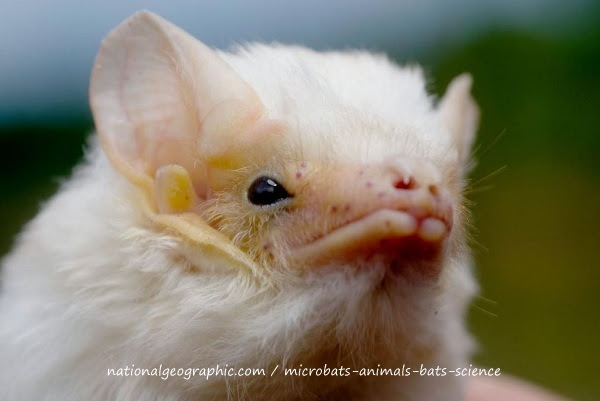Microbats (pictured, a ghost bat in Peru's Yavari River) range in size from a little over an inch (2.5 centimeters) to more than 5 inc...
Microbats (pictured, a ghost bat in Peru's Yavari River) range in size from a little over an inch (2.5 centimeters) to more than 5 inches (12 centimeters) long.
PHOTOGRAPH BY AMAZON-IMAGES MBSI, ALAMY
For starters, old females are tougher than young males, according to a new study on these little-known mammals.
By Rachel A. Becker, National Geographic TUE AUG 04 2015
A bat the size of a bumblebee? It's no joke—many of the flying mammals come in miniature.
There are about 1,000 species of these so-called "microbats," whose body sizes range from a little over an inch (2.5 centimeters) to more than 5 inches (12 centimeters) long. The plentiful critters make up a whopping 17 percent of all mammals on Earth.
"If you haven't seen them before, they're just amazingly teeny tiny," says Pia Lentini, a bat expert at Australia's University of Melbourne. "And a lot of them have very squished faces." (See "Small Wonder: What Are the World's Tiniest Animals?")
But as tiny critters that dwell in the dark, microbats have gone largely unstudied, their daily lives still a mystery to scientists.
Now, a new study has rounded up a hundred years' worth of research about microbats to create a model for how bats might survive as their populations drop in many parts of the world.
White-nose syndrome, a type of fatal fungus, is wiping out North American microbats by the millions. The mammals are also declining due to human development, such as light pollution and wind farms. (Also see "Killer Fungus That's Devastating Bats May Have Met Its Match.")
But without better information about bats and their biology, conservationists working to protect bats don't know how these threats decrease or change bat life spans.
"That was really the main motivation behind our study," says lead author Lentini, whose research was published August 4 in the journal Biology Letters.
"Let's try and figure out what the commonalities between those species are to see whether we can predict for this new species, what the survival's going to be."
The study revealed, for instance, that female bats that have more babies die at higher rates each year than bats that produce fewer young.
Tiny and Elusive
They may be tiny, but there's a lot to love about microbats.
The creatures use echolocation—or built-in sonar—to catch many insects, including pests such as mosquitoes. They also pollinate plants, including agave, the base ingredient of tequila. (Related: "Tequila's Savior May Be the 'Bat Man' of Mexico.")
And they're surprisingly long-lived for such small-bodied animals. The oldest recorded microbat in the wild died at 41, which goes against the belief that small creatures live fast and die young, Lentini says.
Yet little is known about these long lives, partly because they're notoriously tough to study, says Merlin Tuttle, bat expert and founder of Bat Conservation International.
Not only are microbats nocturnal, every time an individual is caught, examined, or disturbed during hibernation, "we're increasing the odds that the bat will learn to avoid us, or will die prematurely," Tuttle says.
Tough Old Bat
To get around this problem, for her study Lentini grouped 44 bat species in the scientific literature based on size, food source, sex, how many pups they have each year, and where they live.
Then she plugged these traits into a model to predict how long bats with similar traits would live.
She and her colleagues found that age and sex were both good indicators of longevity. Older females were much tougher than younger males, for example.
But the strongest effects came from the bats' diet—fruit eaters lived longer than insect eaters, likely because bats eating fruit spent less time in the open exposed to predators that bats chasing insects.
Likewise, bat pups—up to a third of the weight of the mother—take an enormous toll on bat mothers, which might explain why bat moms who have more babies tend to have shorter life spans.
Lastly, her team studied a wild population of Gould's wattled bats near Melbourne, Australia, and discovered their life spans matched the data from their model. (See more amazing bat pictures).
Next Step, Poo
The main challenge of the study, Tuttle says, is that predicting anything about bats based on existing research is fraught with problems.
Bat behavior is very variable and plastic, he says, even across a single species. "We have to be very careful with how we model studies that are themselves often times just tiny windows into the overall behavior or survivorship of a species,” he says.
As for Lentini, her next step is to figure out what microbats eat. "I just had a student analyze the poo," she says.
Follow Rachel A. Becker on Twitter.










sm flipboard insta done
ReplyDelete